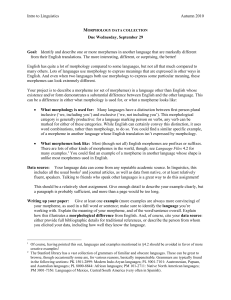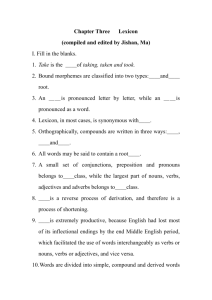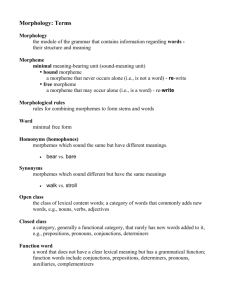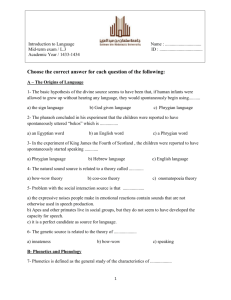Inleiding Taalkunde
advertisement
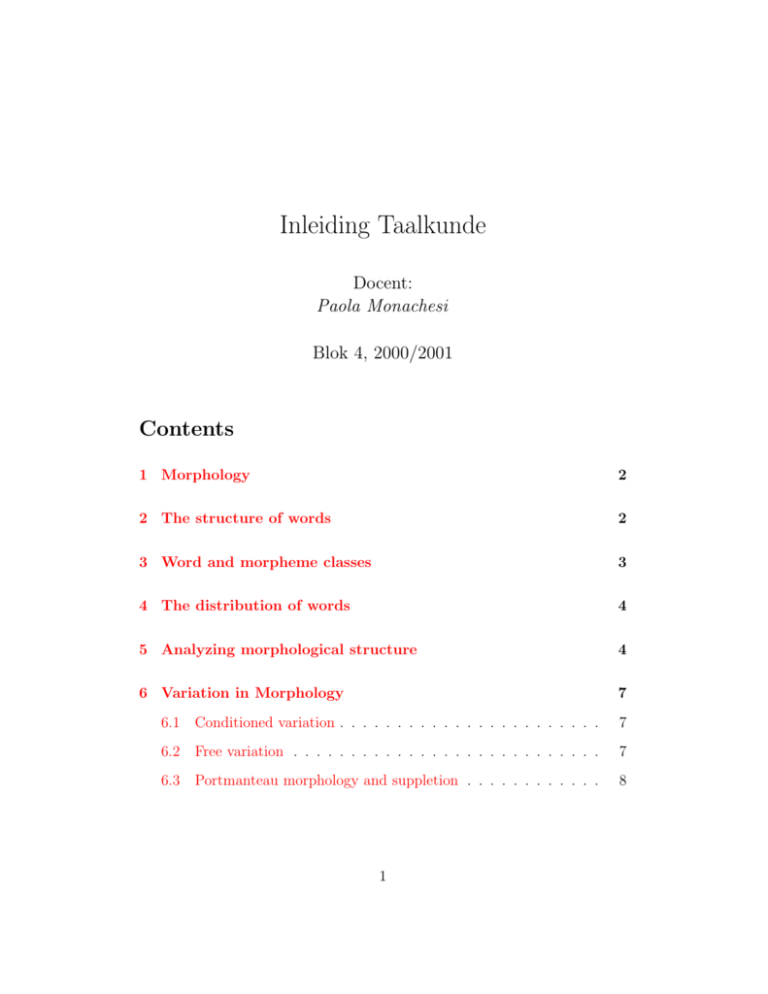
Inleiding Taalkunde Docent: Paola Monachesi Blok 4, 2000/2001 Contents 1 Morphology 2 2 The structure of words 2 3 Word and morpheme classes 3 4 The distribution of words 4 5 Analyzing morphological structure 4 6 Variation in Morphology 7 6.1 Conditioned variation . . . . . . . . . . . . . . . . . . . . . . . 7 6.2 Free variation . . . . . . . . . . . . . . . . . . . . . . . . . . . 7 6.3 Portmanteau morphology and suppletion . . . . . . . . . . . . 8 1 1 Morphology 2 The structure of words • Morphology is the study of words and their structure. • Words are meaningful linguistic units that can be combined to form phrases and sentences. • Words are not the smallest units of meaning. • The boys picked wildflowers in the churchyard for the beautifully dressed Marta • How can the words in the sentence above be decomposed? • How many morphemes (i.e. smaller units) does it contain? • Where are the morpheme boundaries? • What is the difference between Marta and -s ? (free morpheme vs. bound morpheme; lexical morpheme vs. grammatical morpheme). • Terminology: simple vs. complex words; uninflected words vs. inflected and derived words. • disenchanting : division into root, prefix and suffix (i.e. affixes). 3 Word and morpheme classes • Affixes may be described in terms of the class or category of the word they combine with and the category of the new word they form. • Example of affixes: anti-, un-, re-, dis-, -ment, -ize, -ism, -ful, -ly, -er, -s • Which class of words do these affixes combine with? 2 • Sometimes the word class of a word changes when an affix is added and sometimes it does not. • It is possible to identify members of certain word classes in terms of what affixes can be used with them: (i.e nouns with plural with -s, adjectives with comparative with -er, verbs form a singular present with -s, past with -ed and present participle with -ing.) • The set of the words made from a single root is called paradigm. • Example of the English verb paradigm: regular vs. irregular verbs. 4 The distribution of words • The distribution of a word may indicate its word class. • Examples of different frames: a singular noun, an adjective, prepositions. • The use of certain types of morphemes can be illustrated with sentence frames. • Examples: plural suffix, past tense suffix. • Inflectional morphemes are those whose presence is driven by sentence structure. • Inflectional morphemes usually do not change the class of the resulting word. • Derivational morphemes increase the vocabulary, they are a way for new words to enter the language. Their occurence is not related to sentence structure. • Derivational morphemes usually involve a change of class in the resulting word. • Give examples of derivational morphemes from previous list. • Terminology: open vs. closed class; lexical vs. function words. 3 5 Analyzing morphological structure • Segmentation of Swahili sentences: Ninasoma Anasoma Tunasoma Nilisoma Alisoma Nitasoma Tutasoma ‘I am reading’ ‘He/she is reading’ ‘We are reading’ ‘I read’ (past) ‘He/she read’ ‘I will read’ ‘We will read’ • Which morphemes are part of these words? • What do they mean? • Where are the morphemes boundaries? Ninasema Tulisema Atasema Watasema ‘I am speaking’ ‘We spoke’ ‘We will speak’ ‘They will speak’ • Which morphemes are new? • What do they mean? Anamfukuza Ananifukuza Tulimfukuza Walitufukuza ‘He is chasing him’ ‘He is chasing me’ ‘We chased him’ ‘They chased us’ • Which morphemes are new? • What do they mean? • Segmentation of sentences in Tolkapaya Yavapai 4 Chtul-ma ’-chtul-ma M-chtul-ma ’uu-ma ’uu-ma M-’uu-ma ‘He/she washes’ ‘I wash’ ‘You wash’ ‘He/she sees’ ‘I see’ ‘You see’ • Which morphemes are part of these words? • What do they mean? Chtul-ch-ma ‘They wash’ ’-chtul-ch-ma ‘We wash’ M-chtul-ch-ma ‘You (plural) wash’ ’uu-ch-ma ’uu-ch-ma M-’uu-ch-ma ‘They see’ ‘We see’ ‘You (plural) see’ • What is the difference between the two sets of sentences? • Morpheme boundary between two morphemes can be identified if a morpheme can intervene in that position. • Make a table with the subjects. • If the verb changes in keeping with the number, person or gender of a subject, this is referred as subject-verb agreement. • What does the morpheme -ma mean? Chtul-ma ’uu-ma ‘He/she washes’; ’He washed’, ’She washed’ ‘He/she sees’; ‘I saw’ 5 Chtul-ha ’uu-ha ’uu-ch-ha ‘He/she will wash’ ‘I will see’; ‘We will see’ • Give example with glosses. • Prefixes and suffixes follow a certain order. They seem to fill slots in a template. • Give template. 6 Variation in Morphology 6.1 Conditioned variation • Conditioned variation occurs if in one environement the morpheme appears and in another it doesn’t or it might involve a difference in pronunciation. (i) cat/cat[s] vs. cad/cad[z]; (ii) tap/tap[s] vs. tab/tab[z]; (iii) Reebok/Reebok[s] vs. bog/bog[z]; s and [z] are two allomorphs of the English plural morpheme, that is two different forms which are used in different phonological contexts. 6.2 Free variation • Free variation is morphological variation in which no conditioning environment can be stated. • Example from the Zapotec language spoken in San Lucas Quiavini’ (Oxaca), Mexico. 6 R-a’ihsy-eb R-zhihby-eb ’He (formal) sleeps’ ’He (formal) gets scared’ R-a’ihsy-iny/ni’ ’He (reverential) sleeps’ R-zhihby-iny/ni’ ’He (reverential) gets scared’ • iny and ni’ are two allomorphs of the reverential morpheme. 6.3 Portmanteau morphology and suppletion • It is not always possible to divide a word into morphemes. • He decided to buy flowers for Marta vs. He thought of buying flowers for Marta. • We decided to buy flowers for Marta vs. Marta decided to buy flowers for us. • A morpheme which contains more than one non-segmentable meaningful element is called portmanteau. • Irregular related forms such as we us are called suppletive. Ohter examples are: be and were or good and well. 7



